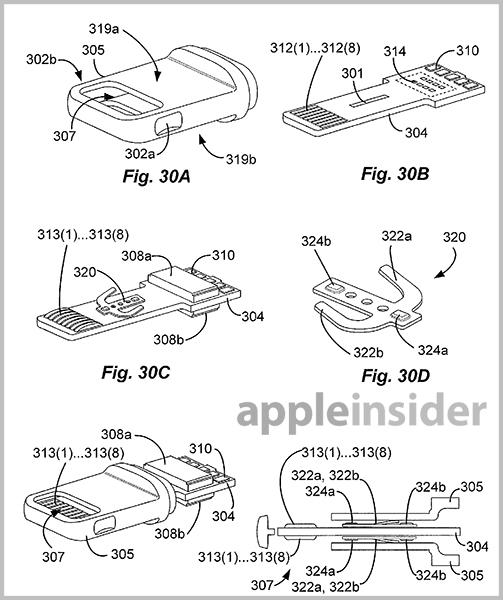A trio of Apple patent applications filed with the U.S. Patent and Trademark Office on Thursday reveals the intricacies of the company's latest input/output protocol for iOS devices: the Lightning connector.
When Apple introduced Lightning alongside the iPhone 5 in September 2012, not much was known of the protocol besides its small size and orientation agnostic design, two vast departures from the venerable 30-pin dock connector it replaced.
Further investigation, including a teardown that found a built-in authentication chip, revealed that the new connector dynamically assigned contact pins to allow for reversible use. Processing was thought to be executed by a control unit onboard the iPhone, though the true inner workings of the protocol remained largely unknown.
The three patent applications discovered today yield a detailed look into how Lightning works, both from the accessory side and the iPhone or host device side, as well as how the physical connector is designed to facilitate reliable operation.
Starting with construction, Apple's patent filing for a "Dual orientation connector with external contacts and a conductive frame" is an incredibly in depth overview of Lightning's hardware design, build and proposed functionality.
With Lightning, Apple looked to overcome deficiencies with previous connectors, including industry stalwarts like the ubiquitous 3.5mm headphone jack and USB. In designing the new protocol, the company needed something short enough to allow for the inclusion of increasingly large mobile device screens, and thin enough to accommodate consumer demand of ultra-slim form factors.
Also considered was signal interference due to the accumulation of debris in connector cavities and ease of use associated with how a plug is oriented when inserted into a device. Finally, the "feel" of a connector was accounted for, with unwanted wobble and imprecise insertion and extraction being a sticking point.
In order to retain the tab, for example, detents are employed on the metal sheath, while arms on the female side hold the connector in place. A similar mechanism was used in Apple's 30-pin connector.
One the most important considerations was creating a multiple orientation connector. In many of the invention's embodiments, the Lightning connector's pin arrangement and overall "tab" design are discussed. While each has its own pin layout, all point to a flattened part with two large surfaces flanked by two smaller surfaces, or sidewalls.
Contacts on the connector include a ground, multiple data signal pins and ID pins to denote orientation. The problem with creating an orientation agnostic design is how to facilitate the identification of each pin on the connector. To solve this dilemma, Apple disposed an ID module that is operatively coupled to the pin contact on the device side.
In one embodiment, the invention calls for a set of rules regarding the location of data signal pins and ground contacts, with the positioning either mirrored on both sides of the tab, or disposed opposite each other. The wiring within the tab, which is consequently associated with the correct pinout, connects contacts on one side of the tab with its partner contact on the opposite side. However, it should be pointed out that two contacts, accessory ID and accessory power, are located kitty-corner to each other on opposing sides of the tab. This configuration allows for the dual orientation compatibility seen in Lightning.
The application goes on to explain the various electrical requirements needed to make the system work, including per-pin voltages and internal wiring. Also noted are manufacturing techniques to produce the new standard.
Apple's Lightning hardware patent was first filed for in November 2012 and credits Albert J.Golko, Eric S. Jol, Mathias W. Schmidt and Jeffrey J.Terlizzi as its inventors.
The two remaining patent applications (1, 2), both titled "Techniques for configuring contacts of a connector," deal with the dynamic assignment of pins on the connector by a host side identification system.
Basically, the properties describe the host and accessory systems needed to dynamically assign pins a certain role, whether it be as a data signal contact or a power contact.
Various pin designs for Lightning.According to the patent language, in one embodiment the contacts are configured by first detecting the mating of two conncectors. In response, the host unit sends a command through two host-side contacts and, depending on which returns a valid response is received, determines the orientation of the connector.
In operation, a switch for a first orientation detection contact is opened and a command signal is sent from the host device. If a viable signal is returned, which can be translated by the ID module, the orientation process stops and orientation is set. If, however, no signal is received, as would be the case if the connection is with a power line, the OD1 switch is closed and OD2 repeats the process.
As noted above, the accessory power and accessory communication contacts are located kitty-corner to one another, thus if an OD contact finds the accessory comm pin, the correct orientation of the connector can be deduced.
From this information, the remaining connectors can be dynamically assigned with correct power and data signal pathing.
After describing the hardware requirements, the filing goes into detail describing how the aforementioned ID module can be programmed with identification and configuration information to successfully communicate with the connector. An authentication module is used to serve up an encryption key routine with the host device, while a current regulator embedded in one of the ID chips can function as a voltage regulator.
The patent applications were filed for in November and December 2012, and credit Jeffrey Terlizzi, Scott Mullins, Alexei Kosut, and Jahan Minoo as their inventors.
 Mikey Campbell
Mikey Campbell











-m.jpg)






 William Gallagher
William Gallagher
 Wesley Hilliard
Wesley Hilliard

 Christine McKee
Christine McKee
 Malcolm Owen
Malcolm Owen

 Andrew Orr
Andrew Orr





-m.jpg)




59 Comments
Next feat for Apple would be to come up with a new headphone jack standard and force it onto the market. I would support that completely...
It's a real contrast. Lighting is almost perfect from a physical point of view: small, reversible and a firm fit, but has a relatively low data rate. Thunderbolt on the other hand is wobbly even when plugged in, and has big chunky connectors in order to move certain circuitry external, but it has a screaming data rate, the fastest of all ports. Take your pick...
[quote name="ascii" url="/t/157440/apples-lightning-connector-finally-detailed-in-patent-filings#post_2324229"]It's a real contrast. Lighting is almost perfect from a physical point of view: small, reversible and a firm fit, but has a relatively low data rate. Thunderbolt on the other hand is wobbly even when plugged in, and has big chunky connectors in order to move certain circuitry external, but it has a screaming data rate, the fastest of all ports. Take your pick...[/quote]
Gee... All that circuitry would certainly work well with this.... http://appleinsider.com/articles/13/04/23/apple-invention-would-allow-for-peripheral-based-authentication-password-recovery
I totally agree. Put that kinda speed in the Lightning connector and you'd have a new industry standard for sure. Apple PLEASE READ THIS!!!!